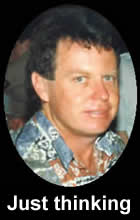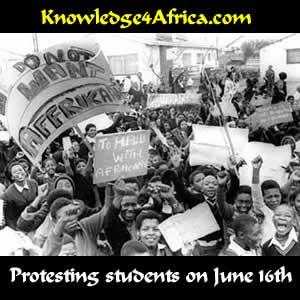|
READ THIS
The poet places himself in the shoes of one of the teenagers who participated in the Soweto
uprising of June 16, 1976. He sees himself the day before the event, foreseeing the tragedy
that is due to erupt.
Notice how the poet portrays a hum-drum, happy-go-lucky life of the innocent victims of the
brutality that was about to happen.
 THE SOWETO UPRISING
THE SOWETO UPRISING
After taking power in South Africa in 1948, the National Party systematically worked on its plan
of social engineering which it called Apartheid. The goal was to divide every aspect of the
country along racial lines, and create homelands for the Black population.
In 1953 the Bantu Education Act introduced this plan into the schools. The aim was to educate
the Black youth into becoming permanent servants.
"There is no place for the African in the European community above the level of certain
forms of labour," stated Dr H.F. Verwoerd, the architect of Bantu Education. "It is of no
avail for him to receive a training which has as its aim, absorption in the European
community."
Initial protest against Bantu Education was minimal, with only the Catholic Church mounting
spirited opposition.
By the 1970s, however, the Apartheid system itself was beginning to show cracks.
Furthermore, the rapidly developing industrial state needed educated youth. The schools that
were created in Soweto to meet this demand, however, became the melting pot for opposition
to Bantu Education.
On 16 June 1976, high school children from Soweto began a protest march for a better
education system. Their banners centred on their hatred at being forced to undertake 50% of
their schooling through the medium of Afrikaans which they regarded as the language of
oppression.
The police intervened, attempting to disperse the youth by means of teargas and live bullets.
The resultant massacre of the youth became the rallying point for rolling mass-action that would
eventually see the end of the hated Apartheid system.
June 16 (Soweto Day) is now a public holiday in South Africa, under the title of Youth
Day.
Unfortunately, we have absolutely no information about the poet -- or even a photograph of
him. If anyone could help us, we would be extremely grateful.
Have you looked at the questions
in the right column?
|
TEST YOURSELF!
Read the left column and then answer
the following questions:
This poem is essentially a dirge, a song of sadness to be sung at a funeral.
- Whose funeral is he lamenting? (2)

[Need help?]
The poet is lamenting the deaths of all those children who died when shot by the police while
protesting against their inferior apartheid education.
|
- Comment on the words which the poet uses to highlight this sadness. (4)

[Need help?]
The poet speaks of the sweet memory of youth which has been cut down in its prime. He
remembers those mothers whose hearts are broken by the deaths of their children, the dirges
sung by the women who are lamenting the deaths, the creased foreheads of the old men who
are in shock and in mourning.
And, of course, the poet speaks of the blood that has been shed on this particular day, where
the sunset of life is running red with blood.
|
The poet writes as though he himself were personally involved in the historic event.
- Explain how this is so. (4)

[Need help?]
The poet himself has not just died, of course, or else who is writing this poem? He is, however,
speaking in the first person, putting himself in the shoes of each of the young people who were
struck down by police bullets and died on this particular day. It was a national tragedy and, as
so, was felt by every concerned citizen.
|
"for my sunset is drenched with red"
- Comment on the rich imagery of this line. (4)

[Need help?]
"Sunset" is often a metaphor for the end of life -- death. Here, however, it is not a
gentle death but one which is "drenched with red". Notice the harshness of the word
"drenched". The life of the young people has been ripped apart by police bullets, and
their blood flows freely, drenching the sunset (and streets) with red.
|
"strummed by an old man with a broken brow"
- Comment on the image used in this line. (4)

[Need help?]
The song is being sung by the sad women, wailing for the deaths of their children. They are
accompanied by the old man, strumming a metaphorical guitar of sadness and shock. His brow
is wrinkled with care and sorrow, the broken brow being synonymous with a broken spirit?
|
Is there any purpose to writing a poem that uses no punctuation, and which ignores the usual
rules of grammar? (4)

[Need help?]
It is, of course, a modern thing to write poetry with no punctuation -- yet there is a purpose.
Punctuation confers precise meaning to a sentence. Take away punctuation and the poem
remains open to individual interpretation in all sorts of ways. Lack of punctuation also denotes
a freedom from all rules, which can therefore also be interpreted as portraying a freedom of
spirit.
Do you think the poet has anything specific in mind when he deliberately chooses to avoid
punctuation?
|
Why does the poet couch the poem in the future, giving the impression that he is writing his
thoughts before all the tragic events took place? (4)

[Need help?]
The writing about events of the past as though they still lie in the future bestows a prophetic
quality to the poem. It is not a new genre. Indeed, the biblical book of the "prophet" Daniel
does precisely that -- i.e. it describes events which have already taken place as if they are still
to happen. It helps too in bestowing a more graphic quality to the words.
|
|



